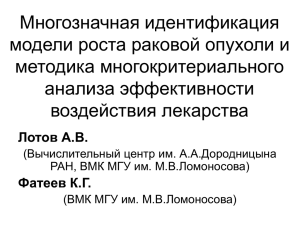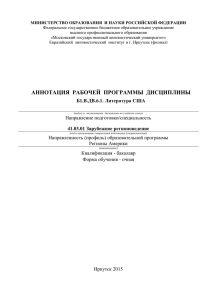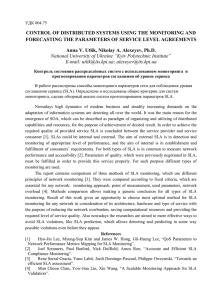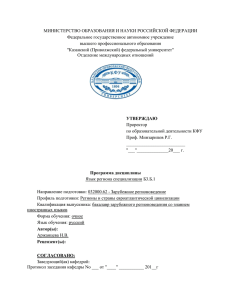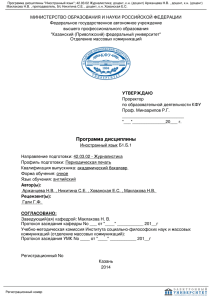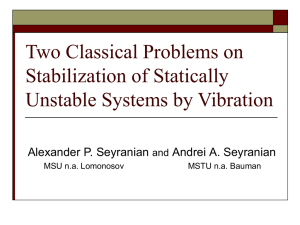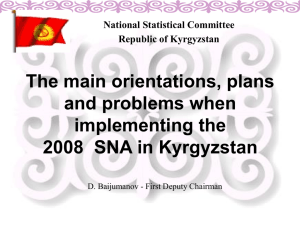Пълен текст - Моделиране и оптимизация
реклама
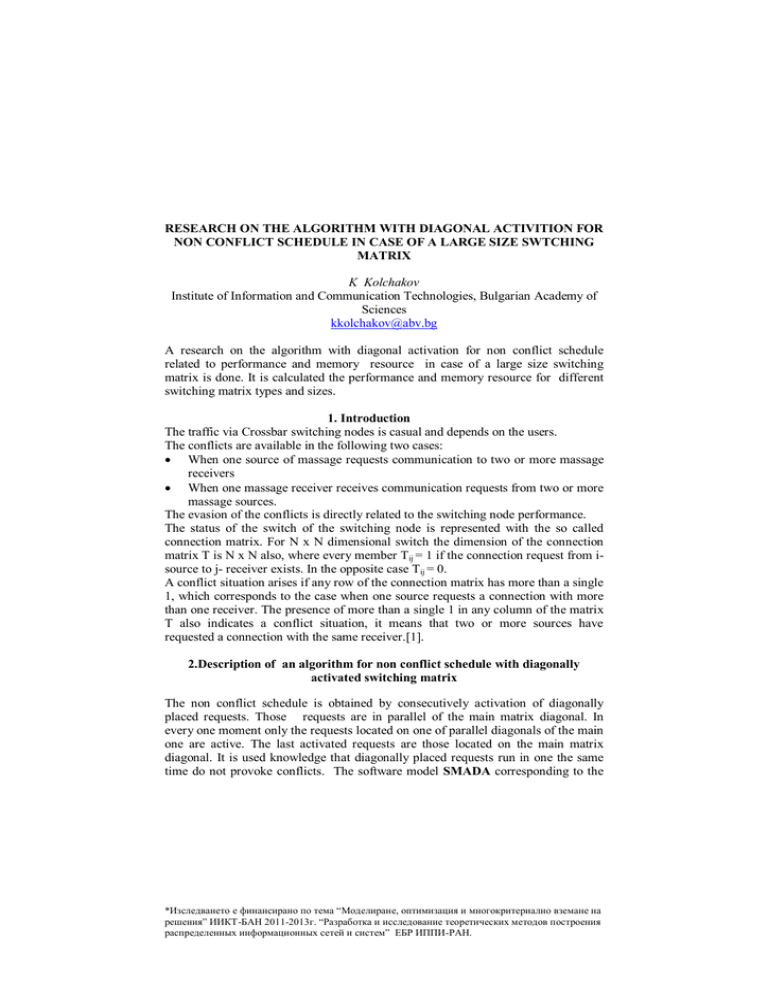
RESEARCH ON THE ALGORITHM WITH DIAGONAL ACTIVITION FOR NON CONFLICT SCHEDULE IN CASE OF A LARGE SIZE SWTCHING MATRIX K Kolchakov Institute of Information and Communication Technologies, Bulgarian Academy of Sciences kkolchakov@abv.bg A research on the algorithm with diagonal activation for non conflict schedule related to performance and memory resource in case of a large size switching matrix is done. It is calculated the performance and memory resource for different switching matrix types and sizes. 1. Introduction The traffic via Crossbar switching nodes is casual and depends on the users. The conflicts are available in the following two cases: When one source of massage requests communication to two or more massage receivers When one massage receiver receives communication requests from two or more massage sources. The evasion of the conflicts is directly related to the switching node performance. The status of the switch of the switching node is represented with the so called connection matrix. For N x N dimensional switch the dimension of the connection matrix T is N x N also, where every member Tij = 1 if the connection request from isource to j- receiver exists. In the opposite case Tij = 0. A conflict situation arises if any row of the connection matrix has more than a single 1, which corresponds to the case when one source requests a connection with more than one receiver. The presence of more than a single 1 in any column of the matrix T also indicates a conflict situation, it means that two or more sources have requested a connection with the same receiver.[1]. 2.Description of an algorithm for non conflict schedule with diagonally activated switching matrix The non conflict schedule is obtained by consecutively activation of diagonally placed requests. Those requests are in parallel of the main matrix diagonal. In every one moment only the requests located on one of parallel diagonals of the main one are active. The last activated requests are those located on the main matrix diagonal. It is used knowledge that diagonally placed requests run in one the same time do not provoke conflicts. The software model SMADA corresponding to the *Изследването е финансирано по тема “Моделиране, оптимизация и многокритериално вземане на решения” ИИКТ-БАН 2011-2013г. “Разработка и исследование теоретических методов построения распределенных информационных сетей и систем” ЕБР ИППИ-РАН. algorithm is written using MATLAB language and run on DELL Precision 420 workstation. 3. SMADA examination In Table 1 are presented the results of SMADA examination. They are related to the performance and memory resource in case of large switch matrix size. Figure 1 and Figure 2 illustrate graphically the results from Table1. N 500 1000 1500 2000 2500 3000 3500 4000 4500 Performance [ Sec.] Memory[ bytes] 35,0940 10 008 008 104,1090 40 016 008 226,4690 90 024 008 542,4060 160 032 008 817,0150 250 040 008 1333,3000 360 048 008 1857,9000 490 056 008 2328,2000 640 064 008 3792,1000 810 072 008 Table 1: In Table 1 are presented the results of SMADA examination. Performance 4000 3500 [Sec.] 3000 SMADA 2500 2000 1500 1000 500 0 0 1000 2000 3000 4000 5000 N Figure 1: SMADA performance. *Изследването е финансирано по тема “Моделиране, оптимизация и многокритериално вземане на решения” ИИКТ-БАН 2011-2013г. “Разработка и исследование теоретических методов построения распределенных информационных сетей и систем” ЕБР ИППИ-РАН. [kB] Memory 900000 800000 700000 600000 500000 400000 300000 200000 100000 0 SMADA 0 1000 2000 3000 4000 5000 N Figure 2: SMADA memory resource. 4. Software model performance A software models performance (P) is defined as a ratio of the non- nil resolutions to the total number of the solutions. R(v) is the set of the nil solutions, R(w) is the set of the non-nil solutions, and R is a set of the all solutions.[1] R = R(v) + R(w) P = ( R(w) / R ).100[%] (1) (2) From formula 2 it is visible that when the nil solutions R(v) vanish to nil, than the performance P vanish to 100%. To facilitate the performance examination, five kinds of matrixes for simulation of the input connectivity matrix T are chosen. The special input matrixes 2A, 2B, 2C, 2D and 2E are represented on Figure 3. [1] From the input matrixes structure represented on Figure. 3 it is clear that the availability of big amount on nil diagonals brings the lower performance. It is important to be mentioned, that there is a direct proportional relationship between the nil diagonals of the input matrix T and the number of the nil resolutions. *Изследването е финансирано по тема “Моделиране, оптимизация и многокритериално вземане на решения” ИИКТ-БАН 2011-2013г. “Разработка и исследование теоретических методов построения распределенных информационных сетей и систем” ЕБР ИППИ-РАН. 1 0 0 0 0 0 1 0 0 0 0 0 1 0 0 0 0 0 1 0 0 0 0 0 1 1 1 0 0 0 1 1 1 0 0 2A 0 1 0 1 1 0 0 1 1 0 0 1 1 1 0 0 0 1 1 1 0 0 0 1 1 0 0 1 1 1 0 0 0 1 1 2B 0 1 1 1 1 1 0 0 1 1 1 0 0 0 1 1 0 0 0 0 1 1 0 0 1 1 1 0 0 0 1 1 1 0 0 2E Figure 3: Special input matrixes. P[%] 2A 0,100 0,050 0,033 0,025 P[%] 2B 0,300 0,150 0,100 0,075 P[%] 2C 99,69 99,84 99,89 99,92 1 1 1 0 0 1 1 1 1 0 1 1 1 1 1 2C 2D SMADA N 500 1000 1500 2000 1 1 0 0 0 P[%] 2D 99,79 99,89 99,86 99,94 P[%] 2E 50,05000 50,02500 50,01660 50,00125 Table 2: Represents the results of SMADA performance (P) examination for different input matrixes in percents. Figure 4 it is graphical view of the results from Table2. *Изследването е финансирано по тема “Моделиране, оптимизация и многокритериално вземане на решения” ИИКТ-БАН 2011-2013г. “Разработка и исследование теоретических методов построения распределенных информационных сетей и систем” ЕБР ИППИ-РАН. SMADA 120 2C 2D 100 P[%] 80 60 2E 40 20 2A 2B 0 0 500 1000 1500 2000 N Figure 4: Graphical view of the results from Table2. 5.Conclusion From the SMADA examined performance (P) for different input matrixes and different N becomes clear that P is a linear function of N for 2A and 2B Increasing N leads to P reduction and P is under 1%. For input matrixes 2С, 2D and 2 Е , P is not dependant of N. Increasing Р for input matrixes 2А ,2В and 2Е,could be done by the nil solutions elimination. P for SMADA is more than 99% for the widespread traffic type – casual, represented by 2D input matrix. REFERENCES 1. K.Kolchakov, “An Approach for Performance Improvement of Class of Algorithms for Synthesis of Non-conflict Schedule in the Switch Nodes” , Proceedings of the 11th International Conference on Computer Systems and Technologies, CompSysTech’10, 17-18 June 2010, Sofia, Bulgaria, pp.235-239, ISBN 978-1-4503-0243-2. 2. Kolchakov K., Software Models with Sparse Mask Matrixes for NonConflict Schedule obtaining in a Switching Node, Доклад в трудове на международна конференция (DCCN – 2009), “Distributed Computer and communication networks DCCN 2009”, Moscow: R&D Company “Information and Networking technologies” ISBN 978-5-9901871-1-5 София, България, Октомври 5 – 9, 2009, стр. 121-126. *Изследването е финансирано по тема “Моделиране, оптимизация и многокритериално вземане на решения” ИИКТ-БАН 2011-2013г. “Разработка и исследование теоретических методов построения распределенных информационных сетей и систем” ЕБР ИППИ-РАН. 2500 3. 4. 5. 6. K.H.Kolchakov, An approach for non-conflict schedule synthesis – modeling and optimization, Доклад в Сборник научных трудов том 10 Интелектуальные системы и технологии УДК 004.896(06), Научная сесия МИФИ – 2008, Москва 2008, стр. 100 – 101, ISBN 978-5-72620883-1. Kolchakov K., A Modeling Approach for Obtaining of a Non – Conflict Schedule, Доклад в трудове на международна конференция (DCCN – 2007), Москва, Русия, Септември 10 – 12, 2007, стр. 168 – 173. Kolchakov K.H., Non-conflict Schedule Synthesis Based on Communication Matrix Scanning, Доклад в Сборник научных трудов том 3 Интелектуальные системы и технологии, Научная сесия МИФИ – 2007, Москва 2007, стр.132 - 133. Ташев Т., Железов Р. Моделирование виртуальных выходных очередей для коммутационного узла обобщенными сетями. Proc. of Int. Workshop “Distributed Computer and Communication Networks – DCCN’2010”, October 26-28 2010, Moscow, Russia. RDC ”INT”, Moscow, Russia, 2010, pp.198-203. ISBN 978-5-9901871-2-2. *Изследването е финансирано по тема “Моделиране, оптимизация и многокритериално вземане на решения” ИИКТ-БАН 2011-2013г. “Разработка и исследование теоретических методов построения распределенных информационных сетей и систем” ЕБР ИППИ-РАН.
